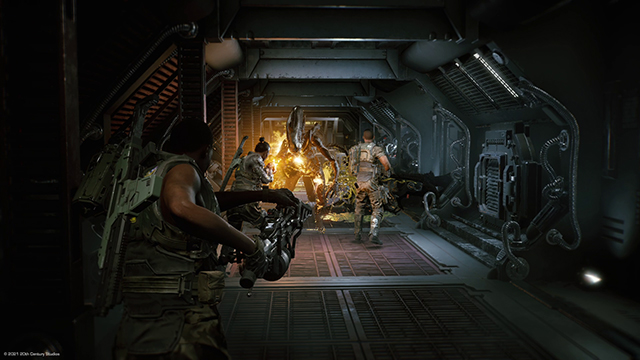While Alien: Isolation was an incredible adaptation of Ridley Scott’s seminal film, James Cameron’s action-heavy follow-up, Aliens, was never as lucky. Decades of mediocrity and downright ineptitude followed the 1986 classic in the video game space even though video games love to take from the concept of a colonial marine that this film established. While far from the mess Gearbox released in 2013, Aliens: Fireteam Elite seems like an average shooter that’s neither as interesting as it should be nor as bad as it could be.
RELATED: James Cameron’s Genius Makes Aliens One of the All-Time Greats
Cold Iron Studios’ Fireteam Elite is, first and foremost, a cooperative experience that’s not too far from what Rebellion churns out every few years (a team that has coincidentally made four Aliens vs. Predator titles). Three players drop into an area and complete a series of simple tasks as hordes of phallic aliens descend on them. There’s a loose semblance of a story here, but it’s entirely forgettable with flat characters that don’t even move their mouths when they speak, as if to further communicate the unimportance of its narrative.
Lacking a story, while a missed opportunity, isn’t a huge deal as that wasn’t the focus. Cold Iron Studios CEO Craig Zinkievich spoke about how the developer filled with PvE fans went with its interests and its strengths while also praising Creative Assembly for making a horror game that provided a different type of Alien experience.
“Alien: Isolation did an amazing job of getting that Alien, Ridley Scott horror movie vibe where you’re getting chased down by this one monster over and over again,” said Zinkievich. “We really wanted to make a bombastic, [James] Cameron-esque action movie Aliens fantasy.”
He continued, stating the importance of the emergent and constantly evolving player narrative that this type of game can specialize in.
“Immediately, you start thinking about the moments where it’s like, ‘Oh my god, they’re in the room.’ And they just burst in,” he said. “That is the co-op survival shooter. That’s not necessarily story. That’s just over-the-top action. Obviously, the game has its storyline and the four campaigns that link together to tell this story of LV-895. But it’s awesome to have that emergent narrative where it’s like, ‘Remember when this happened?’ And making sure that can get switched up time and time again is core to making it a really cool game.”

Fireteam Elite’s action is rather relentless. There’s a bit of tension-building silence, but there’s almost a constant flood of xenomorphs that range from a few pressuring players to move forward to full-on assaults that make the motion tracker light up like a Christmas tree.
And there are plenty of different types that wonderfully match the natural selection, “form equals function” purity of the xenomorphs. There are bright green xenomorphs that burst as they get near players, aggressive red grapplers, tanky praetorians, and drones that stalk players and hide in the vents after they’ve taken some damage, a rush that is a thoughtful marriage of tension and action that has a good chance of being the best enemy in the game. It’s hard to judge from such a small slice of the game, but Zinkievich claims that enemy encounters can mix up a bit during runs of the same level, but how much variability remains to be seen.
Shooting aliens feels good enough and there are five different classes to pick from that each have their own abilities that often encourage the playstyle they are built around. Landing consecutive shots as the Gunner yields a damage boost while another ability juices the firing rate and reload speed of the immediate team members. The Doc class not only regenerates their ability faster when allies are nearby, but their combat stims also enhance the group’s stamina regeneration, accuracy, and movement speed, which fills the support role well. There appears to be enough synergy here to encourage a light bit of teamwork while also giving each class a distinctive feel. They’re quite prepared, which is a key reason why these space marines are able to mow down a foe that seems almost unkillable in most of the movies it is in.
“If you go in unprepared, then a single runner from Alien 3 would be able to take out a full group of people,” said Zinkievich. “But you do play as a colonial marine. They’ve been running into xenomorphs for a couple of decades by 2202 when Aliens: Fireteam Elite takes place. They have weaponry that is ready for xenomorphs. But they’re still not pushovers. They’re still going to throw numbers at you if they can’t get you with just singletons. It’s about who you’re playing and as colonial marines; you do get your M41 [Pulse Rifle] and Smartgun.”

There’s a mix of weapons and abilities that can all be unlocked, upgraded, and customized in some way, giving the game a decent bit of RPG mechanics and replayability. Players can even earn modifiers called Challenge Cards that can mix up the game’s rules for one mission and dole out better rewards to counteract the temporary debuff. It’s all fairly standard and that unshakable sensation permeates the entire experience. Aliens: Fireteam Elite feels just a bit basic and rudimentary.
The aforementioned lack of lip-syncing is just part of the problem since the visuals look behind the times. Lighting is flat — something that’s very noticeable in its dim environments — and character models should be covered in armor at all times to hide their graphical shortcomings. Some of the animations are also stilted in spots, such as the way the Smartgun unnaturally slides into position from its holster. Aliens: Fireteam Elite isn’t a full-priced game (the base version is $40) so it makes some sense, but that sense doesn’t make it any easier to look at. While the presentation is authentic with the film-faithful HUD, the atmosphere takes a hit when it looks and moves so primitively.

The actual gameplay isn’t as dated, but it can be a tad numbing at times. Players will have to tinker with it to find the best setting as it’s a cakewalk on standard difficulty. Aliens are highlighted, their acidic blood barely stings, and it’s easy to destroy a whole Hadley’s Hope-level of the buggers without breaking a sweat, especially in co-op. Without any meaningful pressure, shooting devolves into a semi-mindless routine devoid of actual stakes; the opposite of the frantic tension of the film it is trying to emulate.
Intense, the game’s next difficulty, is a much more welcome and appropriately demanding challenge since enemies aren’t highlighted, acidic blood is more lethal, and guns have some friendly fire, just to name a few of the new restrictions. There are even two higher difficulties that further strip away handholds, but the harder experiences won’t be available for everyone. Three people join the lobby no matter what and solo players will be met with AI companions (who are cleverly synthetics instead of fleshy humans).
But these androids are quite stupid and not capable enough for anything above standard or any of the more demanding Challenge Cards. The game even literally tells the player that the AI is not recommended for those more difficult settings. This oddly transparent oversight keeps solo marines from getting to encounter the better parts of the game; something that co-op players might also experience when playing on standard.
With Back 4 Blood just a few months away, Rainbow Six Extraction releasing in January, Arkane’s Redfall on the horizon, and the other PvE shooters that are currently out and still going, it might be hard for Aliens: Fireteam Elite to stick out. It’s functional and sometimes a thrill to tackle with a few friends, but there’s a bit of cruft that might be hard to shake off. But it’s the only game with such an iconic franchise attached to it and, frankly, it’s already easily much better than Aliens: Colonial Marines. It’s just up to the full game to prove how much better and how far that license will take it.










